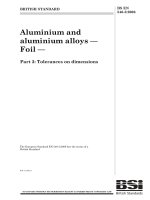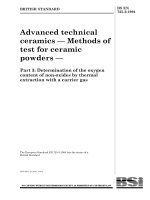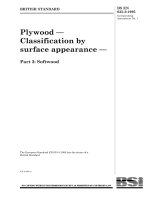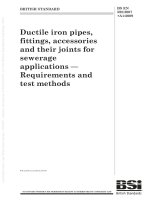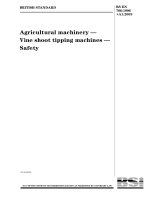Bsi bs en 61300 3 2 2009
Bạn đang xem bản rút gọn của tài liệu. Xem và tải ngay bản đầy đủ của tài liệu tại đây (857.02 KB, 20 trang )
BS EN 61300-3-2:2009
BSI British Standards
Fibre optic interconnecting
devices and passive components
— Basic test and measurement
procedures —
Part 3-2: Examinations and measurements —
Polarization dependent loss in a single-mode fibre
optic device
NO COPYING WITHOUT BSI PERMISSION EXCEPT AS PERMITTED BY COPYRIGHT LAW
raising standards worldwide™
BRITISH STANDARD
BS EN 61300-3-2:2009
National foreword
This British Standard is the UK implementation of EN 61300-3-2:2009. It is
identical to IEC 61300-3-2:2009. It supersedes BS EN 61300-3-12:1997 and
BS EN 61300-3-2:1999, which are withdrawn.
The UK participation in its preparation was entrusted by Technical Committee
GEL/86, Fibre optics, to Subcommittee GEL/86/2, Fibre optic interconnecting
devices and passive components.
A list of organizations represented on this committee can be obtained on
request to its secretary.
This publication does not purport to include all the necessary provisions of a
contract. Users are responsible for its correct application.
© BSI 2009
ISBN 978 0 580 54779 9
ICS 33.180.20
Compliance with a British Standard cannot confer immunity from
legal obligations.
This British Standard was published under the authority of the Standards
Policy and Strategy Committee on 30 April 2009
Amendments issued since publication
Amd. No.
Date
Text affected
BS EN 61300-3-2:2009
EUROPEAN STANDARD
EN 61300-3-2
NORME EUROPÉENNE
March 2009
EUROPÄISCHE NORM
ICS 33.180.20
Supersedes EN 61300-3-2:1999 and EN 61300-3-12:1997
English version
Fibre optic interconnecting devices and passive components Basic test and measurement procedures Part 3-2: Examinations and measurements Polarization dependent loss in a single-mode fibre optic device
(IEC 61300-3-2:2009)
Dispositifs d'interconnexion
et composants passifs à fibres optiques Méthodes fondamentales d'essais
et de mesures Partie 3-2: Examens et mesures Pertes dépendant de la polarisation
dans les dispositifs
à fibres optiques unimodales
(CEI 61300-3-2:2009)
Lichtwellenleiter Verbindungselemente
und passive Bauteile Grundlegende Prüf- und Messverfahren Teil 3-2: Untersuchungen
und Messungen Polarisationsabhängiger Verlust
in Einmoden- Lichtwellenleiter-Bauteilen
(IEC 61300-3-2:2009)
This European Standard was approved by CENELEC on 2009-02-01. CENELEC members are bound to comply
with the CEN/CENELEC Internal Regulations which stipulate the conditions for giving this European Standard
the status of a national standard without any alteration.
Up-to-date lists and bibliographical references concerning such national standards may be obtained on
application to the Central Secretariat or to any CENELEC member.
This European Standard exists in three official versions (English, French, German). A version in any other
language made by translation under the responsibility of a CENELEC member into its own language and notified
to the Central Secretariat has the same status as the official versions.
CENELEC members are the national electrotechnical committees of Austria, Belgium, Bulgaria, Cyprus, the
Czech Republic, Denmark, Estonia, Finland, France, Germany, Greece, Hungary, Iceland, Ireland, Italy, Latvia,
Lithuania, Luxembourg, Malta, the Netherlands, Norway, Poland, Portugal, Romania, Slovakia, Slovenia, Spain,
Sweden, Switzerland and the United Kingdom.
CENELEC
European Committee for Electrotechnical Standardization
Comité Européen de Normalisation Electrotechnique
Europäisches Komitee für Elektrotechnische Normung
Central Secretariat: avenue Marnix 17, B - 1000 Brussels
© 2009 CENELEC -
All rights of exploitation in any form and by any means reserved worldwide for CENELEC members.
Ref. No. EN 61300-3-2:2009 E
BS EN 61300-3-2:2009
EN 61300-3-2:2009
-2-
Foreword
The text of document 86B/2783/FDIS, future edition 3 of IEC 61300-3-2, prepared by SC 86B, Fibre optic
interconnecting devices and passive components, of IEC TC 86, Fibre optics, was submitted to the
IEC-CENELEC parallel vote and was approved by CENELEC as EN 61300-3-2 on 2009-02-01.
This European Standard supersedes EN 61300-3-2:1999 and EN 61300-3-12:1997.
EN 61300-3-2:2009 includes both the all-states method (EN 61300-3-2:1999) and the Mueller matrix
method (EN 61300-3-12:1997).
The following dates were fixed:
– latest date by which the EN has to be implemented
at national level by publication of an identical
national standard or by endorsement
(dop)
2009-11-01
– latest date by which the national standards conflicting
with the EN have to be withdrawn
(dow)
2010-02-01
Annex ZA has been added by CENELEC.
__________
Endorsement notice
The text of the International Standard IEC 61300-3-2:2009 was approved by CENELEC as a European
Standard without any modification.
__________
BS EN 61300-3-2:2009
-3-
EN 61300-3-2:2009
Annex ZA
(normative)
Normative references to international publications
with their corresponding European publications
The following referenced documents are indispensable for the application of this document. For dated
references, only the edition cited applies. For undated references, the latest edition of the referenced
document (including any amendments) applies.
NOTE When an international publication has been modified by common modifications, indicated by (mod), the relevant EN/HD
applies.
Publication
IEC 61300-3-29
Year
-
1)
Title
EN/HD
Fibre optic interconnecting devices and
EN 61300-3-29
passive components - Basic test and
+ corr. November
measurement procedures Part 3-29: Examinations and measurements Measurement techniques for characterising
the amplitude of the spectral transfer function
of DWDM components
Year
2006
2006
2)
www.bzfxw.com
1)
Undated reference.
2)
Valid edition at date of issue.
BS EN 61300-3-2:2009
–2–
61300-3-2 © IEC:2009(E)
CONTENTS
1
Scope and object..............................................................................................................5
2
Normative references .......................................................................................................5
3
Measurement methods .....................................................................................................5
4
3.1 All states method.....................................................................................................5
3.2 Mueller matrix method .............................................................................................6
Apparatus .........................................................................................................................7
4.1
4.2
4.3
5
Optical source (S) ...................................................................................................7
Temporary joint (TJ) ................................................................................................7
Polarization state change system (PSCS)................................................................8
4.3.1 All states method .........................................................................................8
4.3.2 Mueller matrix method .................................................................................9
4.4 Reference branching device (RBD) (optional) ..........................................................9
4.5 Detectors (D)...........................................................................................................9
4.6 Data read-out / recording / processing devices ...................................................... 10
Procedure ...................................................................................................................... 10
6
5.1
5.2
5.3
5.4
5.5
5.6
Data
7
6.1 All states method................................................................................................... 12
6.2 Mueller matrix method ........................................................................................... 13
Details to be specified .................................................................................................... 14
Preparation of specimens ...................................................................................... 10
Pre-conditioning .................................................................................................... 10
Initial measurements ............................................................................................. 10
Test precautions.................................................................................................... 10
Reference measurement ....................................................................................... 10
Device measurement ............................................................................................. 11
analysis.................................................................................................................. 12
www.bzfxw.com
Annex A (informative) Measurement uncertainties ............................................................... 15
Figure 1 – Polarization mapping of deterministic and pseudo-random techniques ................... 6
Figure 2 – Measurement apparatus.........................................................................................7
Figure 3 – Examples of PSCS for the all states method (deterministic and random) ................ 8
Figure 4 – Polarization state change system (example)...........................................................9
Figure 5 – Reference measurement apparatus ...................................................................... 11
Figure A.1 – All states apparatus uncertainty (example: see text for details) ......................... 15
Figure A.2 – Alternate apparatus for Mueller Matrix .............................................................. 16
BS EN 61300-3-2:2009
61300-3-2 © IEC:2009(E)
–5–
FIBRE OPTIC INTERCONNECTING DEVICES
AND PASSIVE COMPONENTS –
BASIC TEST AND MEASUREMENT PROCEDURES –
Part 3-2: Examination and measurements –
Polarization dependent loss in a single-mode fibre optic device
1
Scope
This part of IEC 61300 specifies measurement methods to determine the dependence of loss
in a single-mode fibre optic device to changes in polarization. This procedure focuses on
measurements with a fixed wavelength source; therefore, this procedure is applicable to
devices whose properties at a single wavelength can represent those over the broader
wavelength band. Typical examples of such devices are single-mode interconnecting devices
and passive components, including connectors, splices, branching devices, attenuators,
isolators, and switches. The maximum observed variation in transmission loss is referred to as
polarization-dependent-loss (PDL).
This standard applies to broadband devices and not to narrow-band devices like filters and
multiplexers. The reader is referred to IEC 61300-3-29 for such measurements.
2
Normative references
www.bzfxw.com
The following referenced documents are indispensable for the application of this document.
For dated references, only the edition cited applies. For undated references, the latest edition
of the referenced document (including any amendments) applies.
IEC 61300-3-29, Fibre optic interconnecting devices and passive components – Basic test
and measurement procedures – Part 3-29: Examinations and measurements – Measurement
techniques for characterising the amplitude of the spectral transfer function of DWDM
components
3
Measurement methods
Two methods for measuring polarization-dependent-loss are described. The all states method
determines the maximum variation in transmission loss by stimulating with a representative
set of all possible polarization states including linear, circular, and elliptical. The Mueller
matrix method determines the sensitivity using a set of fixed states and applying the Mueller
matrix mathematical analysis.
This procedure originally consisted of only one method, but has been updated to incorporate
the technique previously described by IEC 61300-3-12 1. That standard will be discontinued.
3.1
All states method
In this method, the PDL is determined by rotating the source polarization over a
representative set of all possible polarization states while monitoring the transmission
—————————
1
IEC 61300-3-12, Fibre optic interconnecting devices and passive components – Basic test and measurement
procedures – Part 3-12:Examinations and measurements – Polarization dependence of attenuation of a singlemode fibre optic component: Matrix calculation method
BS EN 61300-3-2:2009
–6–
61300-3-2 © IEC:2009(E)
response of the device using a power meter. The rotation can be accomplished in either a
deterministic or a pseudo-random fashion.
The term “deterministic” refers to techniques that scan a large subset of the entire polarization
state space in a repeatable way. This method scans the Poincaré sphere along predetermined
trajectories to produce a good approximation of full sphere coverage.
The term “pseudo-random” refers to techniques that scan the polarization through a pseudorandom variation of retardance in the optical path, usually using the distributed retardance of
optical fibre loops in motion.
Figure 1 shows the difference in coverage between the two techniques. In either case, the
accuracy of the method is dependent on the degree of coverage over the Poincaré sphere due
to the combination of the states generated by the polarization controller and the response
time of the power detector with respect to the polarization scan rate.
www.bzfxw.com
IEC 2363/08
Figure 1 – Polarization mapping of deterministic and pseudo-random techniques
3.2
Mueller matrix method
The Mueller matrix method involves the measurement of the behaviour of a device under test,
DUT, when illuminated by a small set of well-defined states of polarization of input light.
These measurements are followed by a matrix calculation to determine the PDL of the DUT.
Generally, there are two matrix formalisms that can describe and quantify the polarization
behaviour of light based on Mueller and Jones calculus respectively. For fully polarized light,
as required for the PDL measurements, the Mueller and Jones formalisms are equivalent.
Since measurements with polarization instrumentation on only one side of the DUT directly
obtain the necessary elements of the Mueller matrix, that is elements corresponding to power
ratios rather than field amplitude and phase, the test procedure described here uses Mueller
mathematics to determine PDL.
The Mueller matrix formalism entails an optical power representation of the performance of
components. This matrix is a square 16-element matrix. Here, the state of polarization (SOP)
of light is described as a 4-element Stokes vector. The Stokes vector of the incident light
multiplied by the Mueller matrix of the DUT gives the Stokes vector of the output light, and
this output light may be from transmission, reflection or scattering. In the determination of
PDL of a component using Mueller matrices, it is normally not necessary to determine the full
Mueller matrix but rather only the first row of the matrix, which provides complete information
on light intensity but not on the resultant state of polarization.
The accuracy of the method is dependent on the source wavelength stability, the system
signal to noise ratio, and the drift in system birefringence.
BS EN 61300-3-2:2009
61300-3-2 © IEC:2009(E)
4
–7–
Apparatus
The basic apparatus for making PDL measurements is shown in Figure 2.
TJ
Source
PSCS
RDB
TJ
DUT
D2
D1
Data
recording
IEC 2364/08
Figure 2 – Measurement apparatus
The apparatus consists of the following devices.
4.1
Optical source (S)
An optical source capable of producing the spectral characteristics defined in the relevant
specification (both wavelength and spectral width) shall be used. Unless otherwise specified
in the relevant specification, the spectral width shall be appropriate for the degree of
wavelength resolution required.
www.bzfxw.com
The source power must be capable of meeting the dynamic range requirements of the
measurement when combined with the detector sensitivity.
The source must be polarized to at least 13 dB extinction ratio, unless otherwise specified in
the relevant specification. An extinction ratio of 20 dB may be used to assure that this
parameter makes no significant contribution to the measurement uncertainty. If the source is
not already polarized to this level, a polarizer should be used to maintain this extinction ratio
over the range of wavelengths of the measurement.
The optical power stability, degree of polarization (DOP), state of polarization (SOP) stability,
and wavelength stability of the source shall be sufficient to achieve the desired measurement
accuracy over the duration of the measurement. For some applications, a narrow linewidth
source such as a single longitudinal mode laser may be used though care shall be exercised
to prevent back-reflections that could lead to multi-path interference and resulting spurious
PDL.
The output from this source is either via a single-mode fibre or a coupling system capable of
launching into a single-mode fibre. Care shall be taken that only the fundamental transverse
mode of the fibre is propagating as outlined in Clause 5.
NOTE
Multimode lasers may not provide sufficient polarization stability for this measurement.
4.2
Temporary joint (TJ)
This is a method, device, or mechanical fixture for temporarily aligning two fibre ends into a
reproducible, low-loss, low-PDL joint. This may be mechanical connectors, mechanical splices,
a direct optical launch into the pigtail, or a splice onto the source's pigtail. Typically, a fusion
splice is used after the polarization controller since mechanical connections may exhibit some
polarization sensitivity if the end-faces are not perpendicular to the fibre axis. The stability
and insertion loss of the temporary joint shall be compatible with the required measurement
precision and dynamic range, respectively.
BS EN 61300-3-2:2009
61300-3-2 © IEC:2009(E)
–8–
4.3
Polarization state change system (PSCS)
The selection of the PSCS will be dependent upon the test method selected.
4.3.1
All states method
For the all states method, the polarization state adjuster is used to vary the polarization of the
input signal over the entire Poincaré sphere. This may be done by continually adjusting a
quarter-wave/half-wave retarder pair placed in the optical path in a well-defined phase
relationship (deterministic) or by using a polarization scrambler (pseudo-random, e.g.
consisting of three or more movable fibre loops). Some examples are provided as follows:
–
bulk optics elements
This may be formed by a cascade of three polarization selective optical elements (only two
optical elements may be sufficient if the state of polarization before the polarization
adjuster is already established by the source). The alignment of the system shall be
adequate to ensure the reproducibility of launched power for the same orientation of the
optical elements. The example in Figure 3a shows a linear polarizer P, half-wave
retardation plate H, and a quarter-wave retardation plate Q mounted on rotation stages
and inserted into a collimated optical path.
–
in-line all-fibre polarization adjusters
This may be formed by a cascade of three rotatable mandrels around which single-mode
optical fibre is wound. This solution is shown in Figure 3b.
www.bzfxw.com
P
H
Q
Input pigtail
of the DUT
S
Rotation stages
IEC 2365/08
Figure 3a – Bulk optic PSCS
S
TJ
TJ
In-line polarization adjuster
Input pigtail
of the DUT
IEC 2366/08
Figure 3b – In-line fibre PSCS
Figure 3 – Examples of PSCS for the all states method (deterministic and random)
The accuracy of the all states method is highly dependent upon the ability of the PSCS and
detector combination to sufficiently sample the polarization space and the stability of the
PSCS insertion loss as the polarization is varied. Annex A discusses the uncertainty
associated with the all states method.
BS EN 61300-3-2:2009
61300-3-2 © IEC:2009(E)
4.3.2
–9–
Mueller matrix method
For the Mueller matrix method, the PSCS is the means by which the launch light can be
conditioned into several well-defined states of polarization representing linearly independent
Stokes vectors. Although any such states can be used, a typical choice is the set of linear
horizontal, linear vertical, linear diagonal, and right hand circular. The equations of 6.2 are
based on this choice. The required accuracy of determining the four states depends on the
required PDL accuracy; as a guideline an accuracy of <+/– 0,5° is proposed. An example of
this system is shown in Figure 4.
0°
Pol. B
90°
Pol. C
45°
Pol. D
¼λ
Pol. A Retarder
Input light
beam
Output light
IEC 2367/08
Figure 4 – Polarization state change system (example)
This arrangement can launch four states of polarization consisting of circularly polarized light
plus three linearly polarized states oriented at 45° with respect to each other. The input light
is first conditioned to a highly linearly polarized state by a polarizer (A). It is then converted to
circular polarization by a quarter-wave retarder oriented at 45° to the polarizer. The three
linear states of polarization can be created sequentially by sequentially inserting the three
polarizers labelled B, C, and D into the beam. Polarizers B, C, and D are oriented at 45° with
respect to each other when they are in the beam. The alignment of the system shall be
adequate to ensure the reproducibility of launched power for the same orientation of the
polarizers.
www.bzfxw.com
Other means to reproducibly adjust the state of polarization are permitted, for example using
bulk optical elements like in Figure 3a, or using liquid crystal variable retarders or preprogrammed fibre polarization controllers.
4.4
Reference branching device (RBD) (optional)
This is a device that transfers power from the input port to two output ports with approximately
a 50:50 or other suitable coupling ratio. The optimum ratio will depend on the signal level
available and the power sensitivity of the reference detector. Unless otherwise specified, it
shall exhibit less than 10 % of the minimum polarization dependence specified as acceptable.
Note that the dynamic range of the measurement will be dependent on the coupling ratio.
The use of the RBD is optional as it is only suggested to use a source power monitor. If the
source power is stable to an order of magnitude better than the DUT PDL to be measured, it
can be omitted.
4.5
Detectors (D)
All detectors used shall have sufficient dynamic range to make the measurement in
conjunction with the rest of the measurement apparatus. The detectors shall have a
polarization sensitivity that is an order of magnitude better than the measurement to minimize
the error. If required, a depolarizer may be used after the DUT and before the detector to
achieve the required accuracy.
The detectors shall be linear over the optical power levels expected to be encountered. Any
detector nonlinearity and polarization dependence contributes directly to measurement error.
Therefore, it is important that the detector and associated amplification circuits exhibit good
BS EN 61300-3-2:2009
– 10 –
61300-3-2 © IEC:2009(E)
linearity over all measurement ranges. Measures shall be taken to ensure that the power
density at the detector is always sufficiently below the saturation level of the detector. It is
recommended to operate at least 3 dB below the saturation level, defined as the power level
at which the relative accuracy specification of the measurement equipment is exceeded. In
this case, the amplifier usually contributes the most to nonlinearity, particularly when the
transimpedance is changed as the ranges are switched. Measurement of low PDL values can
usually be achieved without changing ranges.
The detector(s) shall have sufficient active area and be placed sufficiently close to the output
to capture all of the light exiting the output fibre of the DUT.
For the all states method if the polarization is scanned continuously, the detectors shall be
able to measure power quickly enough, in relation to the polarization scanning rate, such that
the measured values correspond to well resolved states of polarization. This is usually
determined by the bandwidth and the averaging time of the detectors.
4.6
Data read-out / recording / processing devices
These provide a means to collect the transmitted power as the state of polarization is scanned,
to perform the calculations, and to report the results at the end of the test. A computer-based
system may be used to fulfil this data acquisition and analysis function.
5
5.1
Procedure
Preparation of specimens
www.bzfxw.com
Prepare and clean the specimen in accordance with the manufacturer’s instructions.
5.2
Pre-conditioning
No pre-conditioning is required for this measurement unless otherwise specified in the
relevant specification.
5.3
Initial measurements
Complete initial examinations and measurements on the specimen as required by the relevant
specification.
5.4
Test precautions
Movement of any of the fibres during the measurement may affect the SOP and lead to
measurement error. Therefore, care shall be taken to ensure that no movement of the fibres
or apparatus is allowed. This is particularly true for the Mueller matrix method and is generally
less of an issue for the all states method.
Cladding modes shall be stripped at the entry and exit ports of each element of the apparatus.
If this is not accomplished by the fibre coating, cladding mode strippers are required.
5.5
Reference measurement
Starting with the apparatus as shown in Figure 2, remove the DUT from the set-up as shown
in Figure 5. The DUT may be completely removed as shown in the upper setup of Figure 5 or
a fibre loop of length equivalent to the length of the pigtails on the device may be substituted
as shown in the lower setup of Figure 5. In either case, none of the apparatus test cables
should be removed during this step.
Begin with the PSCS set to the first polarization state, and collect the power in watts from D1
and (if used) D2.
BS EN 61300-3-2:2009
61300-3-2 © IEC:2009(E)
– 11 –
Rotate the PSCS through all SOP to be used in the measurement method and collect the
power from D1 and D2 for each point.
TJ
Source
PSCS
RDB
D1
D2
Data
recording
Optional
fibre loop
TJ
Source
PSCS
TJ
RDB
D1
D2
Data
recording
IEC 2368/08
www.bzfxw.com
Figure 5 – Reference measurement apparatus
The reference shall be recorded for each measurement point i as
P1 (i )
P2 (i )
(1)
Pref (i ) = P1 (i )
(2)
Pref (i ) =
where
P1
is the power reading at D1; and
P2
is the power reading at D2
or if D2 is not used, then
5.6
Device measurement
Reconfigure the apparatus as shown in Figure 2.
Begin with the PSCS set to the first polarization state, and collect the power in watts from D1
and (if used) D2.
Rotate the PSCS through all SOP to be used in the measurement method and collect the
power from D1 and D2 for each point.
The DUT measurement shall be recorded for each measurement point as
BS EN 61300-3-2:2009
– 12 –
61300-3-2 © IEC:2009(E)
P1 (i )
P2 (i )
(3)
Pmsd (i ) = P1 (i )
(4)
Pmsd (i ) =
where
P1
is the power reading at D1; and
P2
is the power reading at D2
or if D2 is not used, then
6
Data analysis
6.1
All states method
For the all states method, if the sampled polarization states of the measurement can be
assigned to those of the reference, then calculate the transmission for each data point as:
T (i ) =
Pmsd (i )
Pref (i )
(5)
www.bzfxw.com
Calculate the PDL (maximum delta) and average insertion loss, IL, expressed in dB, as:
PDL = 10 x log10 (Tmax / Tmin )
(6)
IL = −10 x log10 ((Tmax + Tmin) ) / 2)
(7)
where
Tmax
is the maximum value for all T (i ) and
Tmin
is the minimum value for all T (i ) .
If the reference and measurement samples are not made at the same polarization states, as
with pseudo-random scanning, then the transmission cannot be separately calculated for each
sample. In this case calculate PDL as
PDL = 10 x log10 ( Pmsd ,max / Pmsd ,min )
(8)
and calculate the PDL of the setup as
PDL setup = 10 x log 10 ( Pref ,max / Pref ,min )
where
Pmsd ,max is the maximum value for all Pmsd (i ) ;
(9)
BS EN 61300-3-2:2009
61300-3-2 © IEC:2009(E)
– 13 –
Pmsd ,min is the minimum value for all Pmsd (i ) ;
Pref ,max is the maximum value for all Pref (i ) ;
Pref ,min is the minimum value for all Pref (i ) .
The PDL setup is then a contribution to the measurement uncertainty and the setup should be
designed to minimize this.
6.2
Mueller matrix method
For the Mueller matrix method, the set of states of polarization described in 3.2 shall be
generated during the reference and measurement processes.
From these states, it is required to generate the first row of the Mueller matrix using the
Stokes parameters.
For the case where the four states used are: linear horizontal ( i = 1), linear vertical ( i = 2),
linear diagonal ( i = 3), and right hand circular ( i = 4); the calculation proceeds as follows.
Calculate the DUT transmission factors as:
T (1) =
Pmsd (1)
Pref (1)
(10)
T (2) =
Pmsd (2)
Pref (2)
(11)
T (3 ) =
Pmsd (3 )
Pref (3 )
(12)
T (4 ) =
Pmsd (4 )
Pref (4 )
(13)
www.bzfxw.com
Next calculate the first row of the Mueller matrix as:
m11 = ( T (1) + T (2) ) / 2
(14)
m12 = ( T (1) − T (2) ) / 2
(15)
m13 = T (3 ) − m11
(16)
m14 = T (4 ) − m11
(17)
Calculate the maximum and minimum transmission factors as:
2
2
2
Tmax = m11 + m12
+ m13
+ m14
(18)
BS EN 61300-3-2:2009
– 14 –
61300-3-2 © IEC:2009(E)
2
2
2
Tmin = m11 − m12
+ m13
+ m14
(19)
Calculate the PDL and average insertion loss, IL, of the DUT, expressed in dB, as:
7
PDL = 10 x log10 (Tmax / Tmin )
(20)
IL = −10x log10 (m11 )
(21)
Details to be specified
The following details, as applicable, shall be specified in the relevant specification:
•
source peak wavelength and spectral width;
•
degree of polarization of the source;
•
description of polarization state change system;
•
effective sphere coverage of apparatus if all states method is used;
•
description of the reference branching device;
•
pigtail lengths;
•
measurement accuracy requirements;
•
measurement method selected;
•
reference method selected;
•
any deviations from this test method.
www.bzfxw.com
BS EN 61300-3-2:2009
61300-3-2 © IEC:2009(E)
– 15 –
Annex A
(informative)
Measurement uncertainties
A.1
All states method
For the all states method, the polarization scrambler used must be able to convert a fixed
input polarization state from a stable optical source into all possible output polarization states.
The PSCS may operate in either a step mode or a continuous scanning mode. In either case
the accuracy is a function of the degree of sphere coverage and the ability of the apparatus to
resolve unique states of polarization for measurement. As this is the case, the PSCS scan
time and the response time of the detector weigh heavily upon the system accuracy.
In general, there are two scanning rate parameters of the polarization scrambler that influence
accuracy. First, the amount of change in SOP over the averaging time of the detector
determines the polarization resolution of the setup. If this change is too large, the samples will
not determine the maximum and minimum values to sufficient accuracy. This can be improved
by either changing the scan rate or the detector averaging time. Second is the amount of time
to sufficiently cover all states of polarization. The relationship between total measuring time
and SOP coverage depends on the method of polarization scanning. If the PSCS changes the
SOP in a random way, then the coverage is determined statistically and generally continues
to increase with longer measuring time. If the PSCS changes in a deterministic way, it may be
repetitive and the coverage does not increase after the full scanning cycle has been
completed.
www.bzfxw.com
To establish system accuracy, a polarization analyser can be used to monitor the SOPs
generated for either the deterministic or pseudo-random techniques. As an example, the error
dependence on run time was calculated (Figure A.1) for the case of a commercial fibre loop
scrambler running at a rate that covers the sphere to 95 % accuracy in 10 s using a detector
with a 20 ms averaging time. It is important to realise that because of internal system drift,
extremely long scans may be counterproductive and the measurement error may begin to
increase.
60
54
48
PDL error ( %)
42
36
30
24
18
12
6
0
0
3
6
9
12
15
18
21
Polarization scan time (s)
24
27
30
IEC 2369/08
Figure A.1 – All states apparatus uncertainty (example: see text for details)
BS EN 61300-3-2:2009
61300-3-2 © IEC:2009(E)
– 16 –
The influence of source stability and detector polarization dependence can usually be
determined easily be evaluating the variation in power values from the reference
measurement of 5.5.
A.2
Mueller matrix method
This method is also subject to certain restrictions in order to produce consistently meaningful
results. Significant uncertainty and inaccuracy may be observed when measurement system
components such as the PSCS and the detectors (D1 and D2) exhibit PDL of the same
magnitude as the test DUT and when the DUT is terminated with long pigtails possessing nonnegligible birefringence. In addition to internal stress, external coiling in the pigtails produces
stress birefringence in an amount proportional to the coil radius. Stress birefringence
generates optical path retardance that alters the relative orientations of the PDL axes of the
PSCS, the DUT and the detector D1. This additional retardance is sometimes irrelevant in the
all-states approach but leads to a non-removable calibration uncertainty in a four-state
measurement. Large static lead birefringence removes required polarization symmetry
between initial baseline measurements without the DUT in place and the final measurement
with the DUT in place. The net effect of large static birefringence is to scale the PDL by
different factors in the baseline and final measurements. In addition, the dynamic lead
birefringence of long interconnecting fibres alters the baseline PDL level during the course of
extended measurements.
To minimize these problems, the following recommendations are made. Use short, straight
leads anchored to a surface for interconnections where possible along with detectors of low
intrinsic PDL (<10 % expected specimen value) and limit measurement time between baseline
measurements. When these conditions are not possible, the orientation of the fibre leads
should be randomised between complete measurements and the measurements averaged in
order to minimize the lead birefringence effects. Note that the most complete randomisation of
the leads must include orientations where the fibre coils do not lie in a single plane.
Alternatively, a second adjuster, PSCS2 with low PDL such as a fibre-loop adjuster, may be
necessary and inserted between the first PSCS and test DUT as in Figure A.2.
www.bzfxw.com
TJ
Source
PSCS
PSCS2
RDB
TJ
DUT
D2
D1
Data
recording
IEC 2370/08
Figure A.2 – Alternate apparatus for Mueller Matrix
___________
www.bzfxw.com
This page deliberately left blank
WB9423_BSI_StandardColCov_noK_AW:BSI FRONT COVERS
5/9/08
12:55
Page 2
British Standards Institution (BSI)
BSI is the independent national body responsible for preparing British Standards.
It presents the UK view on standards in Europe and at the international level.
It is incorporated by Royal Charter.
Revisions
Information on standards
British Standards are updated by amendment or revision. Users of British
Standards should make sure that they possess the latest amendments or
editions.
It is the constant aim of BSI to improve the quality of our products and
services. We would be grateful if anyone finding an inaccuracy or
ambiguity while using this British Standard would inform the Secretary of
the technical committee responsible, the identity of which can be found
on the inside front cover.
Tel: +44 (0)20 8996 9000 Fax: +44 (0)20 8996 7400
BSI offers members an individual updating service called PLUS which
ensures that subscribers automatically receive the latest editions of
standards.
BSI provides a wide range of information on national, European and
international standards through its Library.
Various BSI electronic information services are also available which give
details on all its products and services. Contact the Information Centre.
Tel: +44 (0)20 8996 7111
Fax: +44 (0)20 8996 7048 Email:
Subscribing members of BSI are kept up to date with standards
developments and receive substantial discounts on the purchase price
of standards. For details of these and other benefits contact Membership
Administration.
Tel: +44 (0)20 8996 7002 Fax: +44 (0)20 8996 7001
Email:
Information regarding online access to British Standards via British
Standards Online can be found at www.bsigroup.com/BSOL
Further information about BSI is available on the BSI website at
www.bsigroup.com
Buying standards
Orders for all BSI, international and foreign standards publications
should be addressed to BSI Customer Services.
Tel: +44 (0)20 8996 9001 Fax: +44 (0)20 8996 7001
Email:
You may also buy directly using a debit/credit card from the BSI Shop
on the website www.bsigroup.com/shop
In response to orders for international standards, it is BSI policy to
supply the BSI implementation of those that have been published
as British Standards, unless otherwise requested.
www.bzfxw.com
Copyright
Copyright subsists in all BSI publications. BSI also holds the copyright, in the UK, of the
publications of the international standardization bodies. Except as permitted under the
Copyright, Designs and Patents Act 1988 no extract may be reproduced, stored in a retrieval
system or transmitted in any form or by any means – electronic, photocopying, recording or
otherwise – without prior written permission from BSI.
This does not preclude the free use, in the course of implementing the standard of necessary
details such as symbols, and size, type or grade designations. If these details are to be used for
any other purpose than implementation then the prior written permission of BSI must be
obtained. Details and advice can be obtained from the Copyright & Licensing Manager.
Tel: +44 (0)20 8996 7070 Email:
BSI Group Headquarters
389 Chiswick High Road London W4 4AL UK
Tel +44 (0)20 8996 9001
Fax +44 (0)20 8996 7001
www.bsigroup.com/standards
raising standards worldwide™


